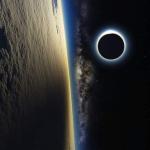Postmodern thinkers like Zygmunt Bauman have pointed to the “liquidity” of contemporary life, its shape-shifting instability. We have nothing on Bonaventure and other medieval doctors, for whom creation was a river flowing from a Triune source. Zachary Hayes ( The Gift of Being: A Theology of Creation (New Theology Studies) , 65-6) explains that the image was drawn from meditation on the circular river of Ecclesiastes 1:7:
According to the medieval reading, the text “envisions the river flowing from the immensity of the sea and eventually returning to the fullness of the point of origin. The divine Trinity, then, can be seen as the fountain-fullness from which the river of reality flows, both within the mystery of God in the triune life of ove, and outside the divinity in the form of creation.”
From this “fountain as something known, loved, and willed into being” flows “the immense river of creation. The world of nature in its vastness is the expression of a loving, intelligent creator. As a reflection of the richness of the creative source, the cosmos can hardly be one-dimensional. On the contrary, like water, it has many dimensions. If, for example, we think of water in the form of a river, it reflects the movement and fluidity of creation. If, on the other hand, we we think of water in the form of an ocean, it suggests the overwhelming fullness of creation as it flows from the depths of God.”
For Bonaventure and others, “the metaphors of the circle, the river, and water elicit a sense of the immense diversity, fertility, and fluidity of creation. No one form of created being is an adequate expression of the immensely fertile source that resides in the divine, creative love.” In all its dimensions, it is “directed in its inner mystery to a fulfillment and completion with God that is the mysterious fruit of its history.”














